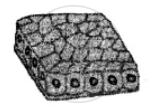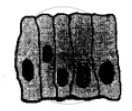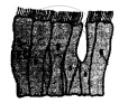Advertisements
Advertisements
Question
Distinguish between Simple epithelium and compound epithelium
Solution
| Simple epithelium | Compound epithelium | |
| 1 | It is composed of only one layer of cells. | It is composed of many layers of cells. |
| 2 | It is mainly involved in the function of absorption and secretion | It is mainly involved in the function of protection and has a limited role in absorption and secretion. |
| 3 | It is present in the lining of the stomach, intestine. | It is present in the lining of the pharynx and buccal cavity. |
APPEARS IN
RELATED QUESTIONS
Based on the following information, identify the three types of epithelial tissue in the figures given below :
| a |  |
b |  |
c |  |
(1) Cuboidal epithelium: It consists of a single layer of cuboidal cells.
(2) Columnar epithelium: It is composed of tall, cylindrical cells with oval nuclei usually placed at the base of the cells.
(3) Ciliated epithelium: It consists of cells being hair-like cilia on their free surface.
Name one place in living organisms where the following tissue is located:
Ciliated epithelium
How many types of epithelial tissues have you studied? Write their functions.
Name the tissues found
at the outer layer of skin.
Name the tissues found:
at the inner lining of the trachea.
Name the tissues found:
in the testes and ovaries.
The ciliated epithelium lines the______.
Some epithelia are pseudostratified. What does this mean?
What is an epithelium? Enumerate the characteristic features of different epithelia.
Nerve cell does not contain
Write true (T) or false (F)
Epithelial cells have a lot of intercellular spaces.
Differentiate between sclerenchyma and parenchyma tissues. Draw well labelled diagram.
The ______ epithelium is also known as the pavement membrane.
An epithelial layer does not allow the regulation of materials between the body and the external environment.
Sieve cells have no companion cells.
Epithelium founds in the lining of stomach and intestine is
Which one of the following types of cell is involved in making of the inner walls of blood vessels?
Name the different cell junctions found in tissues.
